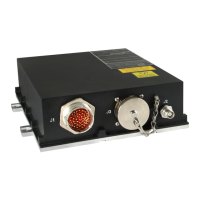INSTALLATION MANUAL
CMA-5024 GLSSU
This document includes Proprietary Information and shall not be reproduced or communicated to third party
without prior written permission by CMC Electronics Inc.
Page 5
Revision 1 Jan 19, 2009
(1) Track the RF signal received from an active antenna,
(2) Determine the signal code phase and carrier phase,
(3) Calculate the antenna position
(4) Correct for the antenna lever-arm errors, if required, to obtain the position of the aircraft navigation
center; this may use aircraft attitude inputs; and last,
(5) Output the navigational data, flight path deviation and other data.
The GLSSU is capable of tracking simultaneously up to 19 L1 C/A code satellite signals, taken from up
to 16 NAVSTAR GPS satellites and up to 3 SBAS satellites. Combining SBAS and GPS satellite
signals improves the navigation accuracy and integrity, in all phases of flight, beyond the level available
from GPS satellites alone.
The Predictive RAIM, Look-Ahead RAIM, and Look-Ahead SBAS functions use a 5 degree mask angle.
The Navigation and integrity functions use a 2 degree mask angle except in SBAS PA mode where a 5
degree mask angle is used. Even though the GLSSU uses a 2 degrees mask angle, it does not depend
on any satellite below 5 degrees to meet TSO requirements. The GLSSU uses a weighted least square
navigation solution with weights as specified in RTCA/DO-229D based on the C/No and the elevation
angles.
The GLSSU uses the WGS-84 ellipsoid as its reference frame and calculates the Mean Sea Level
(MSL) altitude. The GLSSU interfaces with aircraft systems to provide three-dimensional aircraft
position and velocities with associated Figures of Merit (FOM) that can be used for ADS-B. It also
interfaces with aircraft systems to provide a set of satellite position, pseudo-range, and delta-range data
for use in hybrid calculations. For Approach types LP and LPV, it provides path deviation data and
distance to the runway threshold.
Note: The GLSSU is intended to be compatible with ADS-B, as it is being defined at time of writing.
Refer to RTCA DO-242A for technical information and nomenclature.
The GLSSU supports two types of ARINC 429 data output busses:
- GPS Landing System busses (GLS busses or approach busses), and
- GPS busses proper (GPS busses or navigations busses).
The difference lies in the addition of approach guidance data and the higher navigation data throughput
(ten times higher) on the GLS bus. Some systems, especially the older ones intended for legacy
ARINC-734A systems, would be overloaded if operating from GLS busses or may not be compatible
with the approach data, in which case they must be connected to GPS busses. Refer to Appendices A
C D herein for a detailed description of the discrete input/output signals, data busses and data formats.
The GLSSU includes a built-in HIS that accepts and outputs ILS/DME data. The HIS is a high-integrity
digital data hardware switch / software router that is wired to intercept the outputs from the conventional
DME/ILS instruments on their way to the conventional flight instruments in the cockpit. Refer to Figure 5
of this section for a simplified HIS block-diagram.
Under pilot's control, the HIS either forwards transparently the original DME/ILS data to the conventional
flight instruments, or intercepts specific deviation data labels for substituting on-the-fly the look-alike
GLS deviation data that is computed internally using the GPS/SBAS navigation solution. In either case
–ILS source or GLS source respectively- the operation and performance looks the same to the pilots so
that the change is transparent, except for the manual selection of the approach type.
The document reference is online, please check the correspondence between the online documentation and the printed version.

